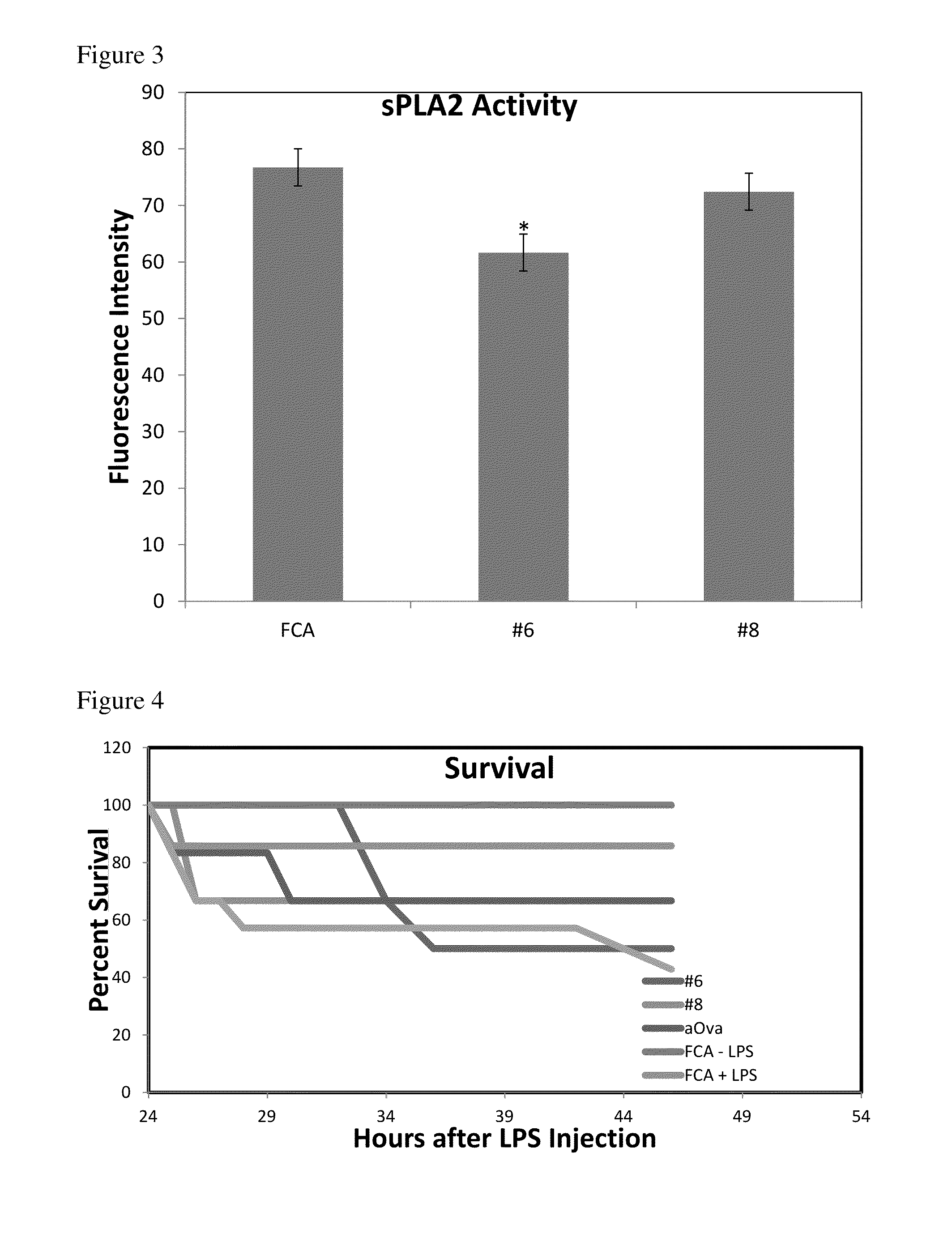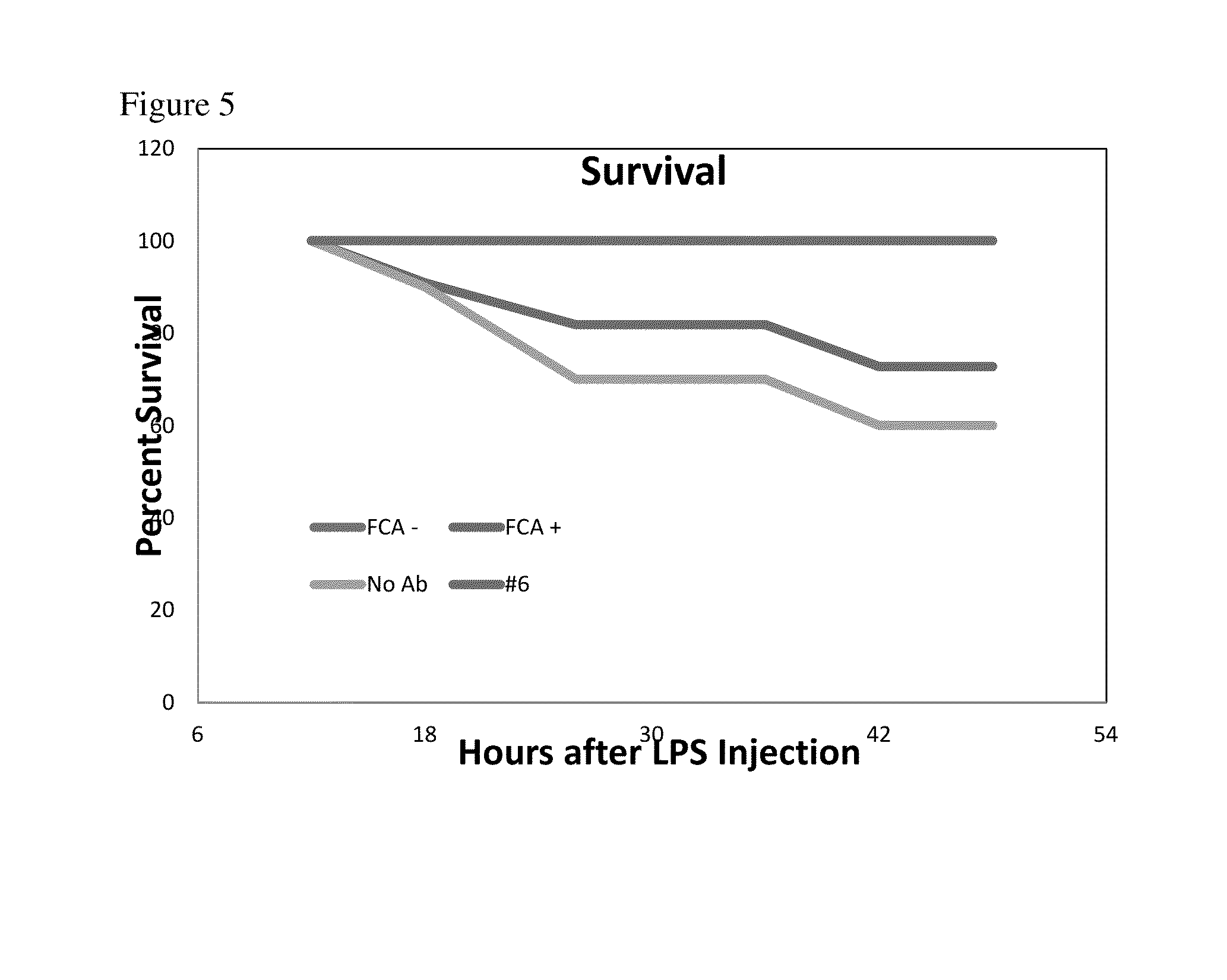Compositions and methods for the treatment of systemic inflammatory response syndromes
a technology of systemic inflammatory response and composition, applied in the field of matter, can solve the problems of septic shock, multiple organ dysfunction, increased risk of infectious systemic inflammatory response syndrome, and death, and achieve the effect of reducing the contribution of the gastrointestinal tra
- Summary
- Abstract
- Description
- Claims
- Application Information
AI Technical Summary
Benefits of technology
Problems solved by technology
Method used
Image
Examples
example 1
Mouse sPLA2-IB Peptide Selection, Antibody Production, and ELISA
[0053]The sequence for mouse sPLA2-IB was sourced from pubmed.gov protein:
NP_035237.1 1(SEQ ID NO. 8) #5 #2 #3 #4mkllllaalltagaaahsispravwqfrnmikctipgsdplkdynnygc #9 #1ycglggwgtpvddldrccqthdhcysqa #8kklesckflidnpytntysyscsgseitcsaknnkcedficncdreaai #10 #6 #7cfskvpynkeyknldtgkfc.
[0054]The bolded portions of the sequence are the peptides identified by an antigen prediction program BepiPred. Sequences were then matched with a solved crystal structure (human sPLA2-IB, 3ELO_A) to determine the placement of these sequences and if the peptides would likely be located in the 3-dimensional structure of the sPLA2 molecule such that the peptides were accessible for antibody binding (surface peptides). Ten eight-amino acid-long sequences were then made into peptides by GenScript (Piscatawy N.J.). Five milligrams of peptide(s) were then conjugated to five milligrams bovine gam...
example 2
Effect of Anti-sPLA2-IB Antibodies on TNFα Release
[0057]aOva Technologies uses an anti-sPLA2-IB antibody generated using the intact sPLA2-IB protein to increase growth rates in animals. This antibody was also shown to decrease the amount of TNFα released in LPS stimulated RAW264.7 macrophages. It was therefore hypothesized that anti-sPLA2-IB (whole protein or peptide segments) specific antibodies that inhibit TNF in cell culture would be anti-inflammatory in vivo and reduce sepsis mortality when given orally.
[0058]RAW 264.7 cells were grown in DMEM with 10% penicillin and 1% streptomycin (ATCC, Atlanta Ga.). RAW 264.7 cells were purchased from the ATCC (Atlanta Ga.). Cells were revived and propagated 3 generations. Cells were then plated and grown to 70% confluence in 12 well plates (24 hours) prior to the start of the experiment. Egg yolk powder containing antibodies (1, 3-10 and FCA) were plated in triplicate at a concentration of 1:100 in RAW 264.7 growth media. Cells were pretre...
example 3
Effect of Anti-sPLA2-IB Antibodies on Protection of Mice from LPS-Induced Endotoxemia
[0060]Antibodies that inhibited TNFα production were then tested in a mouse model of sepsis. All procedures involving mice were approved by the University of Wisconsin, College of Agricultural and Life Sciences Animal Care and Use Committee. Balb / c male and female mice aged 5-6 weeks of age were purchased from Harlan (Indianapolis Ind.). Mice were then caged in groups of 3 and randomly assigned a treatment group. In experiment 1: 3 mice were assigned the isotype adjuvant control antibody (FCA) no LPS, all other groups (antibodies FCA with LPS, #'s 4, 5, 8, 9, 10) were assigned 10 mice / group. Mice were then assigned a diet containing 1% egg powder with the desired antibody in feed and allowed to acclimate to the feed for one week. Mice were then gavaged with 100 uL of a 10% solution of the same antibody that was contained in the feed (0.2 g egg powder / 1.8 mL acidified PBS pH 4.5), and injected with t...
PUM
| Property | Measurement | Unit |
|---|---|---|
| molecular weights | aaaaa | aaaaa |
| temperature | aaaaa | aaaaa |
| volume | aaaaa | aaaaa |
Abstract
Description
Claims
Application Information
 Login to View More
Login to View More - R&D
- Intellectual Property
- Life Sciences
- Materials
- Tech Scout
- Unparalleled Data Quality
- Higher Quality Content
- 60% Fewer Hallucinations
Browse by: Latest US Patents, China's latest patents, Technical Efficacy Thesaurus, Application Domain, Technology Topic, Popular Technical Reports.
© 2025 PatSnap. All rights reserved.Legal|Privacy policy|Modern Slavery Act Transparency Statement|Sitemap|About US| Contact US: help@patsnap.com



